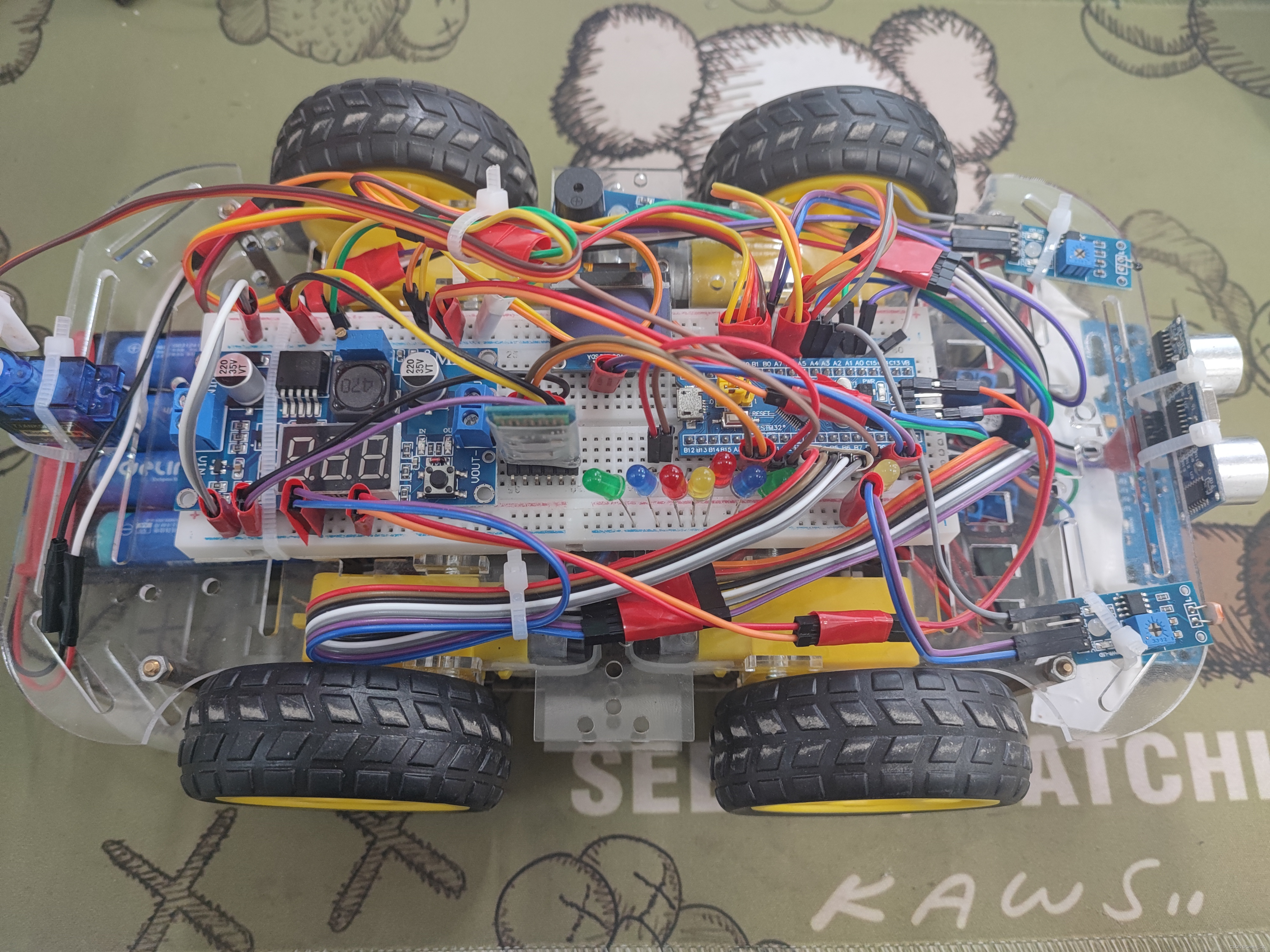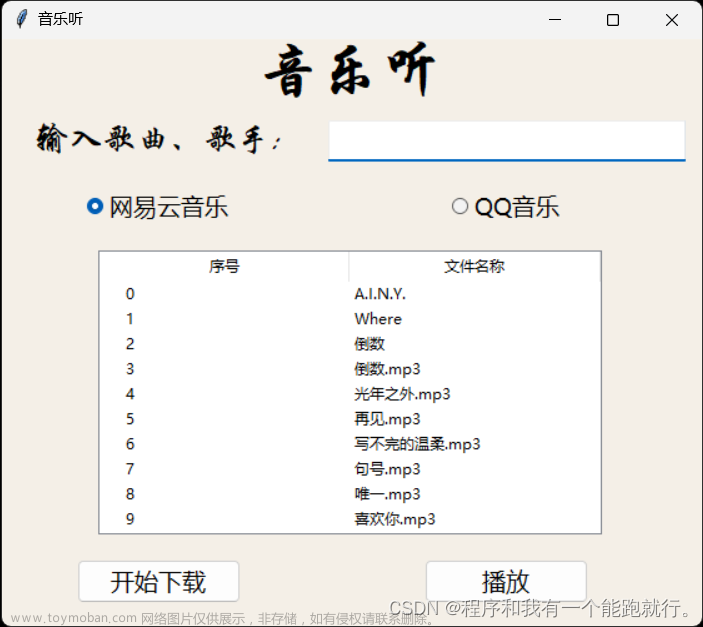一、制作播放器的思路
制作一个多功能音乐播放器的思路
-
确定播放器的需求和功能,例如支持哪些音频格式、播放列表管理、循环播放、暂停、进度条显示等等。
-
选择合适的Python GUI库,例如Tkinter、PyQt等。这些库可以帮助我们在图形界面中实现播放器的各种功能。
-
创建播放器窗口、菜单、按钮、列表等控件,将它们进行布局和排列。
-
编写播放器的逻辑代码,例如读取音频文件、播放、暂停、停止、切换歌曲、循环播放等功能的实现。
-
通过GUI库的事件绑定,将控件的事件和逻辑代码进行关联,使得用户通过点击控件来使用播放器的各种功能。
-
测试播放器的各种功能,并进行修正和优化。
二、制作播放器知识点和所需模块
制作一个多功能音乐播放器需要以下知识点和模块:
-
GUI编程:使用Python的GUI库如Tkinter、PyQt、wxPython等创建图形用户界面。
-
音频播放:使用Python的音频库如Pygame、PyAudio、pydub等实现音频文件的播放。
-
文件操作:使用Python的os、glob等模块来对音频文件进行读取、删除、搜索等操作。
-
线程编程:使用Python的threading模块来实现多线程,使得音频播放和GUI操作可以同时进行。
-
数据结构:使用Python的列表等数据结构来管理音乐列表、播放历史等信息。
-
网络编程:使用Python的socket、Requests等模块来实现在线音乐播放、歌词下载等功能。
实现上述功能可使用的Python模块有:
Tkinter、Pygame、PyAudio、pydub、os、glob、threading、socket、Requests等。
三、播放器的代码展示
以下是Python多功能音乐播放器的逻辑代码:
import pygame
import os
pygame.init()
class MusicPlayer:
def __init__(self):
self.playing = False
self.paused = False
self.volume = 0.5
self.playing_index = None
self.playlist = []
def load_playlist(self, folder_path):
self.playlist = []
for filename in os.listdir(folder_path):
if filename.endswith('.mp3'):
self.playlist.append(os.path.join(folder_path, filename))
def play(self, index):
if self.playing_index == index:
return
if self.playing:
pygame.mixer.music.stop()
self.playing = False
self.playing_index = index
pygame.mixer.music.load(self.playlist[self.playing_index])
pygame.mixer.music.set_volume(self.volume)
pygame.mixer.music.play()
self.playing = True
self.paused = False
def pause(self):
if not self.playing:
return
if self.paused:
pygame.mixer.music.unpause()
self.paused = False
else:
pygame.mixer.music.pause()
self.paused = True
def stop(self):
if not self.playing:
return
pygame.mixer.music.stop()
self.playing = False
self.paused = False
def set_volume(self, volume):
self.volume = volume
if self.playing:
pygame.mixer.music.set_volume(self.volume)
def next(self):
if not self.playing:
return
self.playing_index = (self.playing_index + 1) % len(self.playlist)
self.play(self.playing_index)
def prev(self):
if not self.playing:
return
self.playing_index = (self.playing_index - 1) % len(self.playlist)
self.play(self.playing_index)
def loop(self):
if not self.playing:
return
pygame.mixer.music.queue(self.playlist[self.playing_index])
music_player = MusicPlayer()
music_player.load_playlist('music_folder_path')
def mainloop():
while True:
# 读取键盘事件
for event in pygame.event.get():
if event.type == pygame.QUIT:
pygame.quit()
quit()
elif event.type == pygame.KEYDOWN:
if event.key == pygame.K_SPACE:
music_player.pause()
elif event.key == pygame.K_s:
music_player.stop()
elif event.key == pygame.K_RIGHT:
music_player.next()
elif event.key == pygame.K_LEFT:
music_player.prev()
elif event.key == pygame.K_l:
music_player.loop()
# 设置音量
volume = pygame.key.get_pressed()[pygame.K_UP] - pygame.key.get_pressed()[pygame.K_DOWN]
if volume != 0:
new_volume = music_player.volume + volume * 0.05
new_volume = min(max(new_volume, 0), 1)
music_player.set_volume(new_volume)
# 显示当前播放状态
if music_player.playing:
print('Now playing:', music_player.playlist[music_player.playing_index])
print('Volume:', music_player.volume)
print('Playing:', music_player.playing)
print('Paused:', music_player.paused)
pygame.time.wait(100)
if __name__ == '__main__':
mainloop()
以上代码中, MusicPlayer 类封装了音乐播放器的逻辑功能, load_playlist() 方法用于读取音频文件目录,将音频文件路径存储到播放列表中, play() 方法用于开始播放某一首歌曲, pause() 方法用于暂停/恢复播放, stop() 方法用于停止播放, set_volume() 方法用于设置音量, next() 和 prev() 方法用于切换歌曲, loop() 方法用于循环播放。
在 mainloop() 方法中,使用 pygame.event.get() 方法读取键盘事件,根据不同的按键操作调用 MusicPlayer 类的方法。使用 pygame.key.get_pressed() 方法读取音量调节键盘事件,根据按键情况调用 set_volume() 方法设置音量。最后使用 pygame.time.wait() 方法将程序休眠 100ms,避免 CPU 占用过高。文章来源:https://www.toymoban.com/news/detail-475139.html
此代码可以作为一个基础模板,可以根据自己的需求进行扩展,比如添加显示界面等。文章来源地址https://www.toymoban.com/news/detail-475139.html
到了这里,关于Python制作一个多功能音乐播放器的文章就介绍完了。如果您还想了解更多内容,请在右上角搜索TOY模板网以前的文章或继续浏览下面的相关文章,希望大家以后多多支持TOY模板网!













